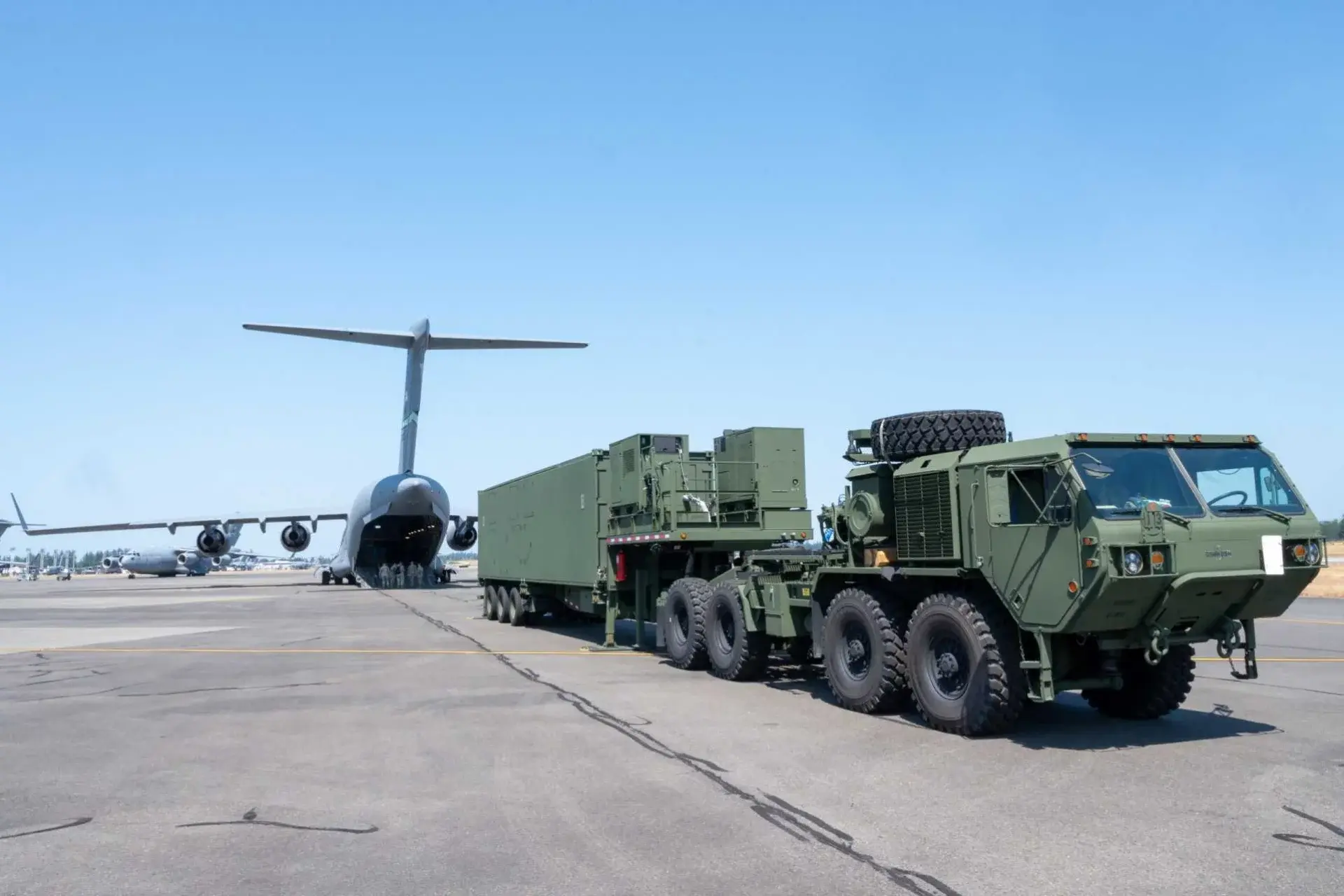Germany has taken the first formal step toward buying the US-built Typhon mid-range missile system. Defense Minister Boris Pistorius lodged the request during two days of talks with US Secretary of Defense Pete Hegseth in Washington on 14 July, officials in both capitals confirmed. The move ends months of speculation about how Berlin intends to plug the range gap between its existing Patriot batteries and the future European hypersonic weapon now in concept studies.
The Typhon package under discussion mirrors the baseline configuration used by the US Army’s Multi-Domain Task Forces. Each battery comes with four trailer-mounted launchers, a battery operations center, power units, reload vehicles, and spares. The launchers employ a modified Mk-41 strike-length vertical cell set that can fire the GPS-guided Tomahawk cruise missile at targets up to roughly 2,500 kilometers away and the SM-6 interceptor at ranges beyond 500 kilometers, depending on the seeker mode. German planners see the dual-missile option as a way to counter both hardened ground sites and maneuvering air-breathing threats with one logistics tail.
For Berlin, the timing is driven by Russia’s accelerating missile inventory. Since late 2024 Moscow has fielded additional Iskander-M brigades in Kaliningrad and Western Military District, upgraded the naval Kalibr line with a digital scene-matching seeker, and resumed limited production of the Kh-32 air-launched weapon. German intelligence assessments leaked to parliament in May warned that a saturated multi-axis strike could overwhelm the current layered shield built around Patriot and IRIS-T SLM if no deeper interceptor were added.
Pistorius told reporters the system “will serve only as a defensive hedge should Russia launch a conventional first strike.” Lawmakers on the Bundestag Defense Committee accepted that rationale but demanded iron-clad guarantees that Germany retains launch authority. Under the draft Letter of Request, Typhon batteries would be crewed by Bundeswehr personnel and tied into the national Air and Missile Defense Command System via a Germanized fire-control software drop. US operators would provide training support but hold no veto over engagement decisions once the transfer is complete.
Cost figures remain sensitive. Industry sources put one battery, including thirty-two Tomahawks, twenty-four SM-6s, and a five-year support package, at about €1.1 billion. That fits inside the medium-range pocket of Berlin’s €100-billion special defense fund and allows room for follow-on buys using baseline procurement accounts from 2028 onward. Finance ministry officials anticipate a first disbursement in the 2026 budget if Washington clears the Foreign Military Sales case by December.
Long-range fires have been Europe’s blind spot since the 1987 INF Treaty eliminated ground-launched missiles with ranges between 500 and 5,500 kilometers. With that accord now void, NATO capitals face a fast-moving threat environment but still lack an agreed inventory plan. Poland and the Baltic states have examined Lockheed Martin’s Precision Strike Missile for shorter engagements, while France is adapting its MdCN cruise missile for a road-mobile launcher. Berlin’s choice of Typhon adds weight to a broader NATO push to standardize on US launch architecture, at least for the next decade.
The procurement schedule outlined by defense officials envisages contract award in mid-2026, followed by a two-year integration phase. The first German battery would train at Fort Sill, Oklahoma, in 2027, move to the Altengrabow training area for acceptance in early 2028, and achieve initial operational capability the same year. A second battery could follow twelve months later if funding is sustained.
Logistics integration poses fewer risks than in the past. Both Tomahawk and SM-6 already use NATO Standard 5066 data links, and their mission planning software runs on the same Joint Mission Planning System Germany adopted for its P-8A fleet. Rheinmetall and Hensoldt have signaled readiness to localize spares and line-replaceable units once volumes justify a service center.
Operationally, the Bundeswehr plans to park Typhon in dispersed revetments rather than at fixed garrisons. The launcher’s ISO-container form factor allows movement by rail, roll-off ship, or A400M transport aircraft. In an alert posture, a launcher can deploy, erect, and fire in under ten minutes, then displace before the launch plume cools – an approach meant to complicate Russian targeting cycles built around satellite and cyber reconnaissance.
Reaction in Moscow has been swift but familiar. The Russian Foreign Ministry called the prospective sale “a direct threat requiring symmetric counter-measures,” echoing language used after US hypersonic deployments in Poland. German diplomats counter that the system simply restores balance after Russia fielded ground-based Kalibr derivatives in 2023.
Inside Germany, the ruling coalition appears aligned. The Greens, once uneasy about long-range strike assets, have backed the purchase after securing a pledge that any export control waiver for Tomahawk software would pass through the Bundestag. Christian Democrat defense spokesman Roderich Kiesewetter welcomed the “belated but necessary step” and urged faster movement on domestic cruise-missile research programs so Berlin is never again wholly dependent on non-European suppliers.
Some members of the Social Democrats worry that putting a 2,000-kilometer missile in Germany could spark protests, like those seen during the Pershing II debate in the 1980s. The Defense Ministry says clear communication about how the system works, along with strict NATO launch rules, should help avoid a public backlash.
Technical experts note that Typhon’s two-stack missile mix covers a broad profile. Tomahawk’s terrain-following flight path fits suppression of logistics nodes and command centers well beyond the front line. SM-6 doubles as an anti-air and limited ballistic-missile defense interceptor, letting operators switch magazines to meet evolving target sets without changing launch hardware. That flexibility drove the US Army to adopt the system under its Long-Range Precision Fires umbrella in 2023.
Technical parameters:
- Launcher format: four Mk-41 strike-length cells per trailer
- Primary missiles: Tomahawk Block V (range ≈ 2,500 km), SM-6 Dual II (range ≈ 500 km)
- Crew complement: forty-six soldiers per battery, including reload and maintenance teams
- Reload cycle: one launcher re-armed in under forty minutes with pre-positioned canisters
While Typhon closes an urgent gap, Berlin is not abandoning European initiatives. Work continues on the trilateral Future Cruise/Anti-Ship Weapon with Paris and London, the German-Norwegian 5G Naval Strike Missile variant for coastal defense, and the European Defence Fund-backed HYDEF hypersonic interceptor. German officials see those programs delivering capability from the early 2030s onward; Typhon fills the interval.
Defense officials confirm that Germany will seek an option to integrate the weapon into the nascent European Sky Shield Initiative. That effort aims to stitch together sensor and shooter data from systems as diverse as Arrow 3, IRIS-T, and Patriot in real time. Typhon’s data bus already supports NATO’s Link 16 and Cooperative Engagement Capability messages, easing the path.
Implementation challenges remain. The Bundeswehr must expand secure ammunition storage, certify road convoys for moving live Tomahawks across federal highways, and train forward observers to cue a missile that can out-range legacy surveillance radars. Berlin also needs to settle basing. Candidates include the growing Missile Defence Wing at Husum and the former US Army depot at Miesau, both offering rail access and hardened bunkers.
Tactically, the system could free Patriot squadrons from counter-cruise missile duty, letting them focus on ballistic threats. Analysts at the Bundeswehr University in Munich calculate that a single SM-6 salvo launched 200 kilometers forward of the front line would cut engagement timelines by thirty-five seconds – an eternity in modern missile combat.
Beyond Germany, the purchase will resonate across NATO. Poland has long eyed Typhon for its Homar-K program, and Romanian commanders have floated the battery structure as a template for the proposed Black Sea littoral defense network. Washington views foreign sales as a means to amortize production lines for both missiles, keeping unit costs down as the US Army buys a projected ten thousand Tomahawks and two thousand SM-6s through 2030.
A secondary benefit for Berlin is leverage in transatlantic burden-sharing talks. By funding its own Typhon batteries – and possibly co-covering Ukrainian Patriot replenishment – Germany can counter US narratives that Europe under-invests in deterrence. Officials argue that parity in long-range fires will deter a unilateral US draw-down of forces on the continent should Washington re-prioritize the Indo-Pacific theater.
Training pipelines are already being drafted. German gunners will attend a transition course at the US Army Fires Center, then return to a renovated classroom block at the Luftwaffe’s Air Defense School in Husum. NATO’s Joint Warfare Centre in Stavanger will host the first command-post exercise that inserts Typhon into the Alliance’s Integrated Air and Missile Defence overlay early in 2028, assuming the acquisition timetable holds.
A separate issue is munitions stockpiling. Current US export regulations cap Tomahawk sales at numbers tied to declared war reserves and training cadence. Berlin will likely begin with a seed inventory of sixty cruise missiles and forty SM-6s, refreshing quantities annually. That mirrors the Australian model adopted in 2024 and gives the Bundeswehr room to refine target lists before committing to larger buys.
Indicative rollout plan:
- Q4 2025 – US State Department clears FMS case; Bundestag Budget Committee releases advance funds
- Q2 2026 – Contract award; first launcher production slot opened at Lockheed Martin Camden plant
- Q3 2027 – German crews start training at Fort Sill; missiles begin shipment to Germany for compatibility testing
- Q1 2028 – Initial battery certified at Altengrabow; enters quick reaction alert
- Q2 2029 – Second battery delivered; national command and control gateway reaches full operational capability
Supporters inside the ministry say the roadmap is “ambitious but achievable” because Typhon is off-the-shelf. Critics counter that sustainment costs could rise if missile recertification intervals shorten under European climate conditions. The Army Materiel Command has begun an environmental test series at Meppen to validate canister life in higher humidity cycles than those seen at US storage sites.
The deal carries industrial upside for German firms. Lockheed is willing to assemble canisters in-country once volumes climb, while MBDA Deutschland could supply launcher power modules. Krauss-Maffei Wegmann has pitched a Rheinmetall HX3 10×10 prime mover tailored for Typhon to replace the US-standard Oshkosh tractors that come with the baseline battery. Early calculations show a forty-percent reduction in through-life cost if Berlin opts for local chassis.
Political pressure to accelerate the transaction will likely remain high. Russian forces retain the ability to strike German critical infrastructure from forward areas such as Pskov or Belarus. Typhon’s planned basing footprint inside Germany adds depth to NATO’s existing shield, compelling Moscow to account for a fresh layer of uncertainty in its operational planning. According to the ministry’s classified threat brief, that unpredictability is the system’s real deterrent value.
Our analysis shows that Typhon offers Germany a credible long-range standoff option without breaking the bank or waiting a decade for European products to mature. If Berlin executes the program on schedule and folds it into NATO’s broader missile-defense lattice, the country will close a vulnerability that has grown since the demise of the INF Treaty, and in doing so, raise the Alliance’s collective threshold against missile coercion.
REFERENCE SOURCES
- https://en.wikipedia.org/wiki/Typhon_missile_system
- https://www.reuters.com/business/aerospace-defense/berlin-pledges-decision-patriots-kyiv-within-days-or-weeks-2025-07-14/
- https://www.defense.gov/News/News-Stories/Article/Article/4243724/hegseth-thanks-german-counterpart-for-stepping-up-to-defense-challenges/
- https://armyrecognition.com/news/army-news/2025/breaking-news-germany-plans-to-acquire-us-typhon-missile-systems-to-strengthen-air-defense-against-russian-missiles
- https://armyrecognition.com/news/army-news/2025/flash-news-following-philippine-deployment-us-army-to-field-new-typhon-missile-system-in-europe-in-2026
- https://www.tasnimnews.com/en/news/2025/07/15/3355165/germany-seeking-2-000km-range-us-missile-launchers
- https://www.agenzianova.com/en/news/Germany-plans-to-buy-the-Typhoon-long-range-missile-launcher-from-the-US/
- https://tass.com/world/1989455
- https://newsukraine.rbc.ua/news/germany-wants-to-buy-us-typhon-long-range-1752570961.html
- https://english.alarabiya.net/News/world/2025/07/15/berlin-pledges-decision-on-patriots-for-kyiv-within-days-or-weeks-
- https://www.congress.gov/crs-product/IF12135



